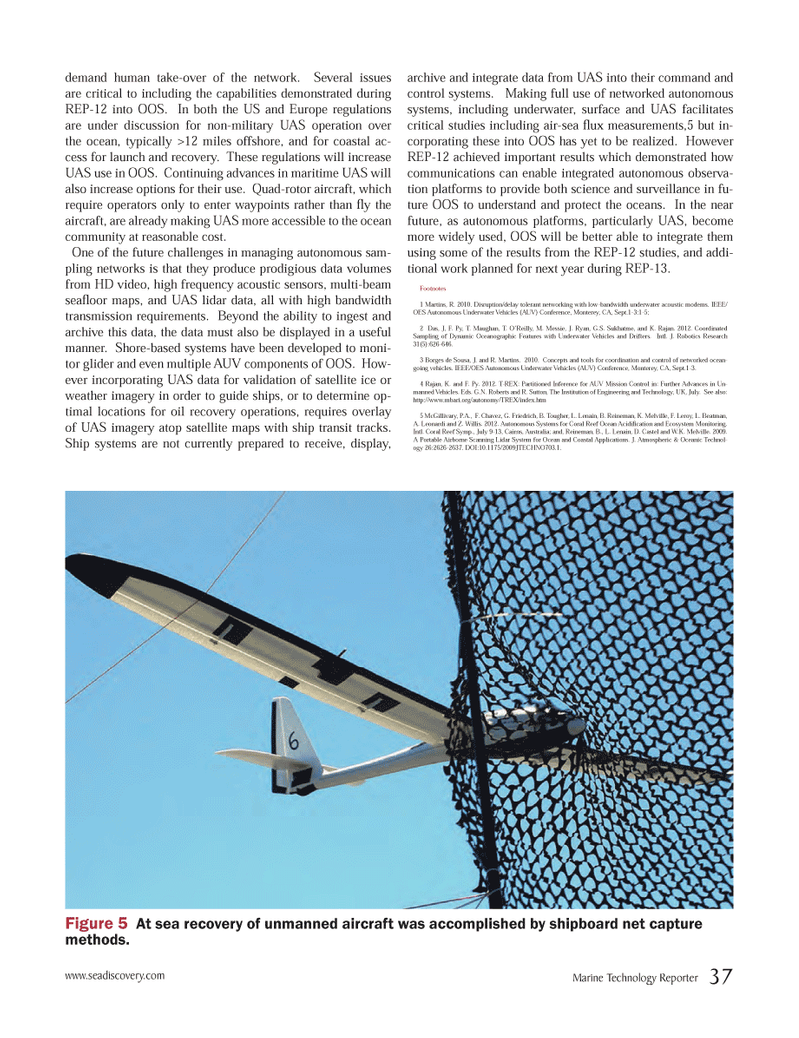
Page 37: of Marine Technology Magazine (October 2012)
Ocean Observation: Gliders, buoys & sub surface monitoring networks
Read this page in Pdf, Flash or Html5 edition of October 2012 Marine Technology Magazine
demand human take-over of the network. Several issues are critical to including the capabilities demonstrated during REP-12 into OOS. In both the US and Europe regulations are under discussion for non-military UAS operation over the ocean, typically >12 miles offshore, and for coastal ac- cess for launch and recovery. These regulations will increase UAS use in OOS. Continuing advances in maritime UAS will also increase options for their use. Quad-rotor aircraft, which require operators only to enter waypoints rather than ß y the aircraft, are already making UAS more accessible to the ocean community at reasonable cost. One of the future challenges in managing autonomous sam-pling networks is that they produce prodigious data volumes from HD video, high frequency acoustic sensors, multi-beam seaß oor maps, and UAS lidar data, all with high bandwidth transmission requirements. Beyond the ability to ingest and archive this data, the data must also be displayed in a useful manner. Shore-based systems have been developed to moni- tor glider and even multiple AUV components of OOS. How- ever incorporating UAS data for validation of satellite ice or weather imagery in order to guide ships, or to determine op-timal locations for oil recovery operations, requires overlay of UAS imagery atop satellite maps with ship transit tracks. Ship systems are not currently prepared to receive, display, archive and integrate data from UAS into their command and control systems. Making full use of networked autonomous systems, including underwater, surface and UAS facilitates critical studies including air-sea ß ux measurements,5 but in- corporating these into OOS has yet to be realized. However REP-12 achieved important results which demonstrated how communications can enable integrated autonomous observa- tion platforms to provide both science and surveillance in fu- ture OOS to understand and protect the oceans. In the near future, as autonomous platforms, particularly UAS, become more widely used, OOS will be better able to integrate them using some of the results from the REP-12 studies, and addi-tional work planned for next year during REP-13. Figure 5 At sea recovery of unmanned aircraft was accomplished by shipboard net capture methods.Footnotes 1 Martins, R. 2010. Disruption/delay tolerant networking with low-bandwidth underwater acoustic modems. IEEE/ OES Autonomous Underwater Vehicles (AUV) Conference, Monterey, CA, Sept.1-3:1-5; 2 Das, J, F. Py, T. Maughan, T. OÕReilly, M. Messie, J. Ryan, G.S. Sukhatme, and K. Rajan. 2012. Coordinated Sampling of Dynamic Oceanographic Features with Underwater Vehicles and Drifters. Intl. J. Robotics Research 31(5):626-646. 3 Borges de Sousa, J. and R. Martins. 2010. Concepts and tools for coordination and control of networked ocean- going vehicles. IEEE/OES Autonomous Underwater Vehicles (AUV) Conference, Monterey, CA, Sept.1-3. 4 Rajan, K. and F. Py. 2012. T-REX: Partitioned Inference for AUV Mission Control in: Further Advances in Un- manned Vehicles. Eds. G.N. Roberts and R. Sutton, The Institution of Engineering and Technology, UK, July. See also: http://www.mbari.org/autonomy/TREX/index.htm 5 McGillivary, P.A., F. Chavez, G. Friedrich, B. Tougher, L. Lenain, B. Reineman, K. Melville, F. Leroy, L. Beatman, A. Leonardi and Z. Willis. 2012. Autonomous Systems for Coral Reef Ocean AcidiÞ cation and Ecosystem Monitoring. Intl. Coral Reef Symp., July 9-13, Cairns, Australia; and, Reineman, B., L. Lenain, D. Castel and W.K. Melville. 2009. A Portable Airborne Scanning Lidar System for Ocean and Coastal Applications. J. Atmospheric & Oceanic Technol- ogy 26:2626-2637. DOI:10.1175/2009JTECHNO703.1.Marine Technology Reporter 37 www.seadiscovery.com MTR #8 (34-49).indd 37MTR #8 (34-49).indd 3710/3/2012 10:03:53 AM10/3/2012 10:03:53 AM

 36
36

 38
38
